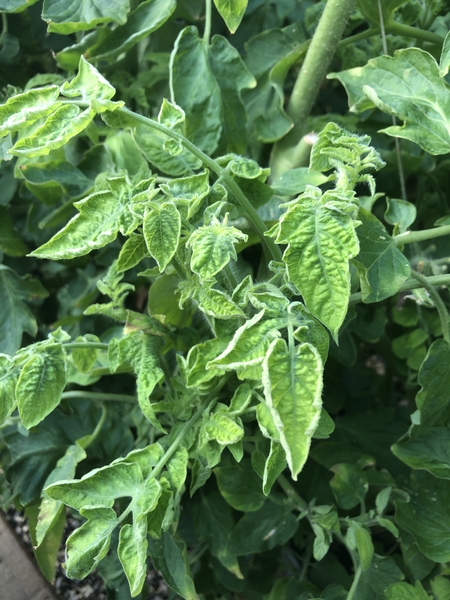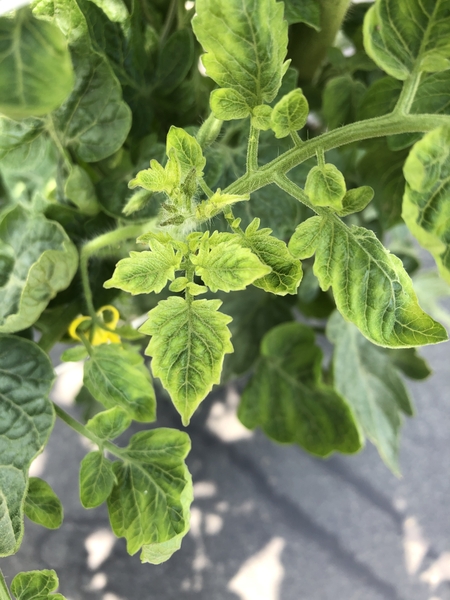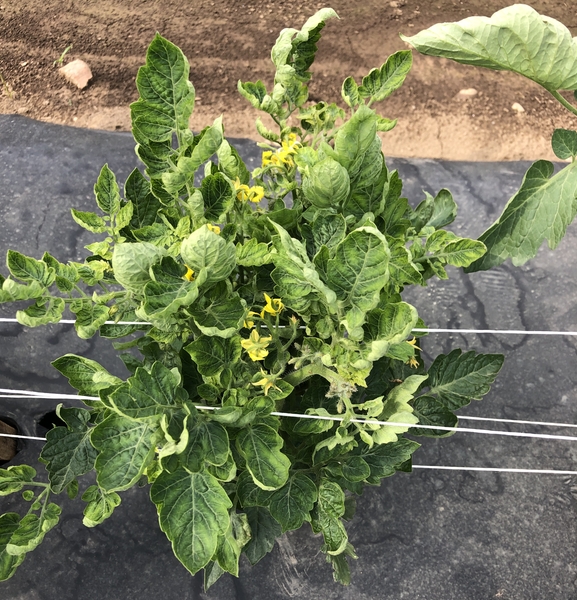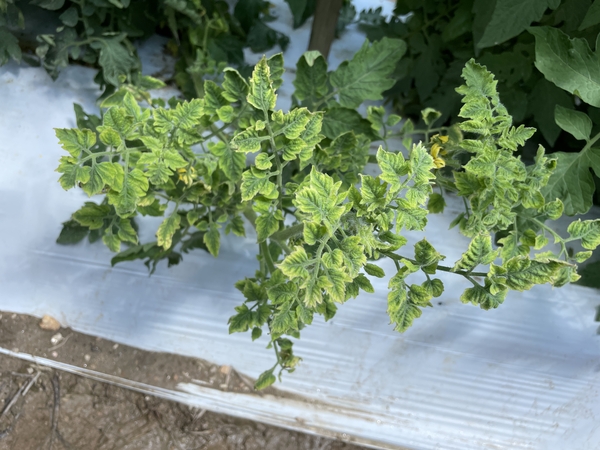Introduction
Tomato yellow leaf curl virus (TYLCV) is a viral disease of tomato that has limited distribution in the United States. TYLCV can cause devastating losses to tomato growers once established in the production site. This viral disease can also be found in temperate, tropical, and sub-tropical regions of the world. TYLCV is transmitted by adult whiteflies and is difficult to control once introduced to an area.
Pathogen
TYLCV is within the genus Begomovirus and family Geminiviridae. TYLCV causes yellowing of young leaves, upward and downward leaf curl (Figure 1), stunting, bushy appearance, and flower drop, which occurs prior to fruit set and dramatically reduces fruit yield.
Host Plants
TYLCV predominately causes disease in tomatoes. It can infect other hosts in the Solanaceae family (pepper, eggplant, potato, tobacco, jimsonweed), as well as common bean (Phaseolis vulgaris L.), and ornamentals including petunia and lisianthus. In the absence of symptoms, these hosts may serve as a reservoir of the pathogen.
Signs and Symptoms
On tomatoes, the primary symptoms of TYLCV are interveinal and marginal chlorosis of young leaves (Figure 2), an overall crumpled appearance of the leaves, and upward and downward leaf-curling. Plants infected with TYLCV will also be stunted in height (Figure 3), and appear bushy due to shortened internode length. Flower drop will occur with an accompanying reduction in yield. When young plants are infected, the disease may be so severe that no fruit is produced. Symptoms can take up to three weeks to develop after infection.
Look-alike conditions
Initial symptoms of TYLCV can resemble other disorders that affect tomatoes, including potassium deficiency, magnesium deficiency, micronutrient deficiencies, and leaf curl. In general, any of these nutrient deficiencies are likely to be consistent across the entire crop whereas plants infected with TYLCV will be patchy across the field and not uniform. This pattern may be used to help diagnose the problem. Potassium deficiency causes the margins of mature leaves to turn necrotic along with interveinal chlorosis. In severe cases, interveinal chlorosis will progress to middle-aged leaves. The primary symptom of magnesium deficiency consists of interveinal chlorosis on the older leaves. TYLCV differs from symptoms of nutrient deficiencies in that the marginal and interveinal chlorosis first appears on young leaves. Deficiencies in micronutrients such as iron, zinc, manganese, and boron may cause chlorosis and deformation of young leaves. Leaf curl can occur during periods of high temperatures and/or drought when the plant’s water supply is disrupted; however, this is often not accompanied by interveinal chlorosis and will first appear on lower leaves. Curling of new leaves may also be caused by excessive aphid feeding or other viruses. It is highly recommended to confirm the diagnosis by a plant disease clinic or extension specialist since there are several lookalike diseases and disorders.
Disease Cycle and Epidemiology
TYLCV is transmitted by adult whiteflies (Bemisia tabaci). A whitefly can acquire the virus within their salivary glands after 15-30 minutes of feeding on an infected plant. After a latent period (time between acquisition and transmission of virus) of ~6 hours, the whitefly is able to transmit the virus to another plant within 15-30 minutes of feeding. Adult whiteflies can retain and spread the virus for several weeks after initially feeding on infected plants and can travel over distances of at least 10 miles. TYLCV can also be acquired by immature whiteflies developing on infected plants, although only adult whiteflies are known to spread the virus. The virus has been detected on seed collected from infected plants. Yet, the virus survives only on the surface of the seed and is not transmissible to seedlings following seed-surface disinfestation. Following infection it may take up to three weeks for symptoms on tomato to appear due to the movement of symptomless infected plant material spreading the disease over long distances. A high population of white flies in mature stages of field-grown tomato production may serve as an inoculum source for younger plantings nearby.
This disease currently poses a threat to tomato production in the Mediterranean, Caribbean, Mexico, Japan, and the southern United States. Bemesia whiteflies are intolerant of winter temperatures. Therefore, the virus is not as much of a threat where the climate does not currently support populations of Bemesia whiteflies, such as in western North Carolina. Tomato transplants produced in other regions infected with TYLCV have been observed in tomato fields in western North Carolina.
General Disease Management
Use disease resistant cultivars
In both field and greenhouse production, planting resistant cultivars is an economical option to manage this disease. Resistant varieties are less effective if tomatoes are infected early in the season. Seed suppliers usually provide disease resistance information. Included below is a table in the Southeastern Vegetable Crop Handbook that includes resistance information for numerous tomato cultivars.
| Fruit Type | Tomato yellow leaf curl resistant variety |
|---|---|
| Cherry/grape | Apple Yellow F1 |
| Ella Bella | |
| Carina | |
| Conde | |
| Conan F1 | |
| Mistral | |
| Red Coral F1 | |
| Plum | BHN-1050 |
| BHN-1045 | |
| Brenda F1 (Roma) | |
| Buena Vista | |
| Corleone F1 | |
| Davinci (Saladette) | |
| Daytona F1 (Saladette) | |
| Invincible | |
| Katya | |
| Mochomo | |
| Oyamel (Saladette) | |
| Pomodoro (Squisito) | |
| Roble | |
| Santa Lucia | |
| Shelby | |
| Valerio | |
| Round | Bejo 3353 (aka Patsy) |
| Botero | |
| Camaro F1 | |
| Carina F1 | |
| Champion II F1 | |
| Charger F1 | |
| Fenda F1 | |
| Grand Marshall | |
| Gurney Gir’s Hybrid | |
| Jolene | |
| Katana F1 | |
| Laguna Red F1 | |
| Marmont F1 | |
| Marnouar F1 | |
| Mountain Gem | |
| Pamella | |
| Purple Zebra | |
| Rally F1 | |
| Red Eclipse F1 | |
| Red Snapper F1 | |
| RidgeRunner | |
| Security 28 F1 | |
| Seventy III | |
| Simplicity | |
| Skyway F1 | |
| Skyway 687 F1 | |
| Sophya F1 | |
| STM 2255 | |
| STM 8135 | |
| Sunfresh | |
| Thunderbird | |
| Tribute F1 | |
| Varsity F1 |
Source clean transplants
Avoid planting transplants that look unhealthy. Look for transplants grown in cooler climates such as western North Carolina since virus transmitting whiteflies do not overwinter in cooler climates. Therefore, avoid transplants from Florida and Georgia.
Rotate with non-host crops on an annual basis
These include non-solanaceous crops such as brassicas (broccoli, kale, cabbage), grain crops (corn, wheat), and winter cover crops (rye, winter pea, etc.). Crop rotation helps prevent the spread of TYLCV and minimizes the chance of the virus being present during the next growing season.
Avoid planting other host plants close to tomato
As a preventative measure, it is best to avoid planting within close proximity to other fields of tomato, pepper, or bean, as they may be reservoirs of the virus.
Monitor the whitefly population in and near the field
Whitefly population management involves the use of pesticides and cultural practices. Adult whiteflies are attracted to white and yellow colors. Placing white and yellow sticky traps in and around a tomato field can help monitor the population. Whiteflies are often found on the undersides of leaves where they lay their eggs. Whitefly eggs are white in color and change to dark blue before hatching. Whitefly nymphs begin feeding with their piercing mouthparts just hours after they hatch. Leaves that have been fed on will exhibit chlorosis and whiteflies will often be visible.
Use reflective mulch
Reflective mulches repel whiteflies and reduce the spread of the virus.
Utilize whitefly proof screening, and ultraviolet (UV) absorbing plastic screens or 50-mesh density covers in greenhouse production
In closed greenhouse production, these measures aim to prevent initial infection with TYLCVvia whiteflies. UV blocking plastic screens and 50-mesh density covers can be purchased at agricultural supply stores, home improvement stores, and hardware stores.
Remove infected plants and destroy them
Infected plants should be removed from the greenhouse or field and disposed of in the landfill or burned.
Disease management for conventional growers
There are various insecticides available for use on tomatoes to reduce whitefly populations which will aid in preventing the spread of TYLCV. Insecticide applications are recommended 4-5 weeks after seedlings are initially planted and should continue as the fruit ripens. Rotate the pesticides to manage whiteflies and avoid insecticide resistance in the pest. Please refer to the list of insecticides labeled for management of whitefly on tomato in the 2023 Southeastern U.S. Vegetable Crop Handbook.
Disease management for organic growers
Implementing preventative measures is the most effective way for growers to avoid TYLCV. Using disease resistant cultivars and rotating the fields with non-susceptible crops are important methods that can reduce the occurrence of TYLCV.
Disease management for homeowners
Homeowners should use the disease management recommendations listed above. Additional products are available for homeowners from home improvement and hardware stores. Neem, pyrethrin, or insecticidal soaps can minimize severe whitefly infestations. Treatments should be applied to the undersides of leaves. The previously listed treatments are most effective when at least two insecticides are rotated during each spraying.
References
Cranshaw, W. 2013. Greenhouse Whitefly - 5.587.
Disease-resistant tomato varieties. 2022. Cornell Vegetables.
Flint, M. 2015. Extension Entomologist Emerita, Department of Entomology, UC Davis Produced by University of California Statewide IPM Program.
Gilbertson, R., Rojas, M., and Natwick, E. 2013. Tomato Yellow Leaf Curl: A New Disease in California Tomatoes. University of California Agriculture and Natural Resources Statewide IPM Program.
Jones, J., et al. 2016. Compendium of Tomato Diseases and Pests, Second Edition. , 15-119.
Moriones, E., Navas-Castillo, J. Tomato yellow leaf curl virus, an emerging virus complex causing epidemics worldwide, Virus Research, Volume 71, Issues 1–2, 2000, Pages 123-134, ISSN 0168-1702, https://doi.org/10.1016/S0168-1702(00)00193-3.
Osborne, L. Pest Alert: Whiteflies.
Perez-Padilla, V., Fortes, I. M., Romero-Rodriguez, B., Arroyo-Mateos, M., Castillo, A. G., Moyano, C., De Leon, L., Moriones, E. 2019. Revisiting seed transmission of the type strain of tomato yellow leaf curl virus in tomato plants. Phytopathology 110:121-129.
Simone, G. Tomato Yellow Leaf Curl Virus Management for Homeowners.
Smith, H. et al. 2019. Management of whiteflies, whitefly-vectored plant virus, and insecticide resistance for tomato production in southern Florida.
Walker, K. 2006. Tomato yellow leaf curl virus (TYLCV) Begomovirus.
Additional Resources
The NC State Plant Disease and Insect Clinic provides diagnostics and control recommendations
The NC State Extension Plant Pathology Portal provides information on crop disease management
The Southeastern US Vegetable Crop Handbook provides information on vegetable disease management
Acknowledgements
This disease fact sheet was prepared by the Meadows Plant Pathology Lab.
Additional review of this factsheet done by Cora McGehee.
Publication date: July 14, 2023
N.C. Cooperative Extension prohibits discrimination and harassment regardless of age, color, disability, family and marital status, gender identity, national origin, political beliefs, race, religion, sex (including pregnancy), sexual orientation and veteran status.




